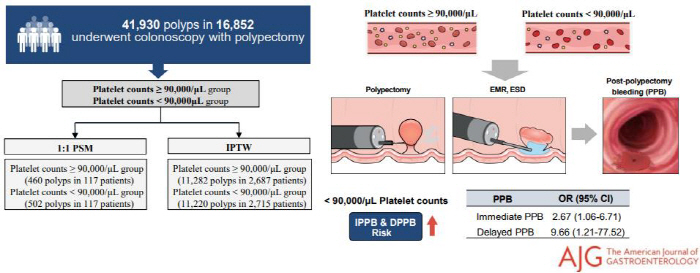Determination of Platelet Levels to Prevent Bleeding in Colorectal Polypectomy
May 27, 2025
|
Regular colonoscopy and polypectomy are widely known as effective methods for preventing colon cancer. However, bleeding may occur after polypectomy, and the risk of bleeding may be even greater, especially in patients with thrombocytopenia.
Existing treatment guidelines had criteria for platelet levels to prevent bleeding, but these were limited to diagnostic endoscopy or biopsy. Accordingly, the research team wanted to establish standards for safe procedures in colon polypectomy and to reveal the effect of thrombocytopenia on bleeding after the procedure.
The research team conducted a large-scale retrospective cohort study based on colonoscopy and polypectomy data conducted at Severance Hospital and Yongin Severance Hospital. In the study, a total of 21,562 patients and 40,30 polyps were analyzed, and propensity score matching and weight analysis were performed in parallel to correct various variables.
The study showed that the minimum platelet count for safe colon polypectomy was 90,000/㎕ (90,000 per microliter). Patients with platelet levels below 90,000/㎕ had an immediate hemorrhage risk of about 2.7 times and a delayed hemorrhage risk of about 9.7 times higher compared to the control group. In high-risk procedures (endoscopic mucosal resection or endoscopic submucosal dissection for large polyps larger than 20 mm), the risk of bleeding was significantly higher at less than 100,000/㎕.
Based on the research results, the research team presented safe platelet count criteria for low-risk and high-risk procedures, and presented practical clinical application guidelines for patient safety, such as reducing the risk of bleeding by applying preventive hemostasis and cold snare to patients at high risk of bleeding.
This study is of great significance in that it clearly presented the minimum platelet criteria for preventing bleeding during colon polypectomy for the first time. In particular, unlike existing guidelines that only presented limited criteria for diagnostic endoscopy or biopsy, the practical clinical contribution is high in that it has established specific criteria for polypectomy, a more invasive procedure.
Professor Hye-kyung Hyun said "The results of this study can be used as an important reference for enhancing the safety of colonoscopy for patients with platelet reduction and for medical staff to make evidence-based judgments."We plan to develop standardized preventive strategies for high-risk bleeding groups along with future multicenter prospective studies."
Meanwhile, the findings were recently published in The American Journal of Gastroenterology.
|
This article was translated by Naver AI translator.















